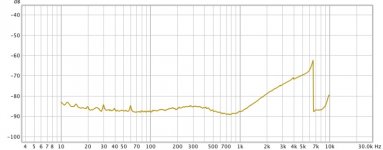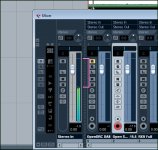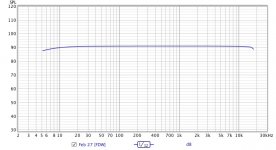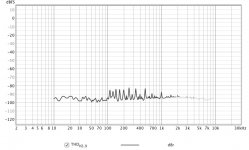This REW THD plot was sitting around. Not sure what where or what but "-80" is ".1%" and I have no idea about that treble bump..
After maybe 12 yrs with the unit and hundreds of measurements of all kinds and with all kinds more gear besides the DSP in the measurement loop, my impression is that the distortion is comparable to a good amp or better.
How can you have a quality audio system without one?
B.
After maybe 12 yrs with the unit and hundreds of measurements of all kinds and with all kinds more gear besides the DSP in the measurement loop, my impression is that the distortion is comparable to a good amp or better.
How can you have a quality audio system without one?
B.
Attachments
This REW THD plot was sitting around. Not sure what where or what but "-80" is ".1%" and I have no idea about that treble bump..
After maybe 12 yrs with the unit and hundreds of measurements of all kinds and with all kinds more gear besides the DSP in the measurement loop, my impression is that the distortion is comparable to a good amp or better.
How can you have a quality audio system without one?
B.
I think -80 is actually 0.01%
Jan
This REW THD plot was sitting around. Not sure what where or what but "-80" is ".1%" and I have no idea about that treble bump..
After maybe 12 yrs with the unit and hundreds of measurements of all kinds and with all kinds more gear besides the DSP in the measurement loop, my impression is that the distortion is comparable to a good amp or better.
How can you have a quality audio system without one?
B.
Is this the DCX2496 distortion spectrum? He’s disgusting, something’s not right here. More similar to the distortion spectrum of cheap class D amplifiers (-62dB at 6.5kHz)
I could do this. The problem with that unit is that you need a 6-channel volume control. I haven't bothered with it since I got some Minidpsp crossovers, even though I now have an Alps 6-channel pot. I kept it to have a play sometime in the future.
I recorded the difference between halved digital vol, and rxv rds 800 (analog) equivalent, as well as the difference full digital and full digital through analog volume on full tap.
Attachments
Is this the DCX2496 distortion spectrum? He’s disgusting, something’s not right here. More similar to the distortion spectrum of cheap class D amplifiers (-62dB at 6.5kHz)
are these measurements done with digital input?
anlog input add another AD conversion worsening the figures
In this thread, one hears an awful lot of criticism of the DCX2496. Here are REW plots I made 5 minutes ago.
About 2-3 lamps on the input and output displays so not pushing to get the most S/N. And all kinds of vintage gear included in the loop adding to the THD (such as the DAC I bought for $4 at the Salvation Army store 15 yrs ago). But I am going from USB to S/PDIF (coax) with a Breeze converter thus skipping a stage or two that others might encounter before and interior to the DCX.
High freq is as high as REW goes and THD about the same as residual noise level.
Not bad, eh.
Enjoy.
About 2-3 lamps on the input and output displays so not pushing to get the most S/N. And all kinds of vintage gear included in the loop adding to the THD (such as the DAC I bought for $4 at the Salvation Army store 15 yrs ago). But I am going from USB to S/PDIF (coax) with a Breeze converter thus skipping a stage or two that others might encounter before and interior to the DCX.
High freq is as high as REW goes and THD about the same as residual noise level.
Not bad, eh.
Enjoy.
Attachments
Last edited:
DCX2496 mods
Hi
Just for fun, modded one of my DCX2496, passive out (taken from article by Thierry Martin) and linear powersupply using a Block 6 volt Trafo and a LT1963 for 3,3 and one for 5.0 volt and for the 8-9 volt just a Block 6 volt trafo diodebridge and some caps, works very well only no display...I used a small 230 to +15/-15 volt
switched psu unit that I can switch off, so now display when needed, compared it to a Selectronic DCX2496 with all the mods that were available at the time, sounds very similar, depth very good, no hum no noise, I am very happy with this modding, cheap and cheerful, like I said just for fun, have no means (or knowledge!) to test it to show measurements, maybe later...
Cheers, Tojoko.
Hi
Just for fun, modded one of my DCX2496, passive out (taken from article by Thierry Martin) and linear powersupply using a Block 6 volt Trafo and a LT1963 for 3,3 and one for 5.0 volt and for the 8-9 volt just a Block 6 volt trafo diodebridge and some caps, works very well only no display...I used a small 230 to +15/-15 volt
switched psu unit that I can switch off, so now display when needed, compared it to a Selectronic DCX2496 with all the mods that were available at the time, sounds very similar, depth very good, no hum no noise, I am very happy with this modding, cheap and cheerful, like I said just for fun, have no means (or knowledge!) to test it to show measurements, maybe later...
Cheers, Tojoko.
To test, like I did in previous post, all you need is REW (donate if your conscience says so) and possibly a DAC, depending on your computer's inputs and outputs. No mic used. All electric.
If you want to move beyond faith and the possibility of self-deception, try REW.
Glad to hear your re-modeling didn't make things sound better or worse. But for all your effort, did it reduce the THD below the astonishingly low level I documented for the stock DCX2496 (using AES input) in my post? Within 1dB from 5 to 25kHz and -85dB (and would have been better with better test circuit).
B.
If you want to move beyond faith and the possibility of self-deception, try REW.
Glad to hear your re-modeling didn't make things sound better or worse. But for all your effort, did it reduce the THD below the astonishingly low level I documented for the stock DCX2496 (using AES input) in my post? Within 1dB from 5 to 25kHz and -85dB (and would have been better with better test circuit).
B.
Last edited:
Respectfully, -80 to -85dB (better than .01%) is perfect in the sense that it is barely indistinguishable from the residual crap level of my tools in this test set-up*, even if it doesn't meet your arm-chair expectations.
If you have an audio unit that is discriminably better by your measurements, love to see you post it. Anybody with one of those trick mods to posts test results?
B.
* with the $4 DAC from the Salvation Army store many years ago
If you have an audio unit that is discriminably better by your measurements, love to see you post it. Anybody with one of those trick mods to posts test results?
B.
* with the $4 DAC from the Salvation Army store many years ago
Ben I know you love the thing stock, I did not. When I first got mine I put it in what used to call the "tape loop". I.E. it could be placed in or out of the signal path at flip of a switch. In the loop it was very obvious that it was there. Its overall sound was somewhat dark and muddy, with a gritty edge. I don't know how to find that in measurements, but certainly someone could. Perhaps that distortion that rises above 1K - which I also found.
The problem all seemed to stem from the analog section, bypassing or replacing those made the device transparent to my ears. Since I normally use the digital input, the analog input didn't get much attention from me, although I've helped others with it. I did a little work on the PSU just to say that I did, it seemed to help. I never messed with the clock, as it didn't seem to be a problem as far as I could tell or hear. Getting the in/out closer to consumer line level certainly helped the noise problem.
The problem all seemed to stem from the analog section, bypassing or replacing those made the device transparent to my ears. Since I normally use the digital input, the analog input didn't get much attention from me, although I've helped others with it. I did a little work on the PSU just to say that I did, it seemed to help. I never messed with the clock, as it didn't seem to be a problem as far as I could tell or hear. Getting the in/out closer to consumer line level certainly helped the noise problem.
Behringer DCX measurements
Hi
I would like to be able to take measurements of my modded DCX, I've got REW software, but no clue how to use that for measurements on the Behringer, what additional hardware is needed and how to connect to Behringer, I only use digital input and 6 analog outs, it is used in a 3 way stereo active set up, only in the low section i used some eq to counter room reflections, to my ears it sounds great just curious how the specs are in real measurements...
Would be great if someone could help here...
Cheers, Tojoko.
Hi
I would like to be able to take measurements of my modded DCX, I've got REW software, but no clue how to use that for measurements on the Behringer, what additional hardware is needed and how to connect to Behringer, I only use digital input and 6 analog outs, it is used in a 3 way stereo active set up, only in the low section i used some eq to counter room reflections, to my ears it sounds great just curious how the specs are in real measurements...
Would be great if someone could help here...
Cheers, Tojoko.
I did a little work on the PSU just to say that I did, it seemed to help.
Hi
Can you share the mods to the PSU?
Hi
I would like to be able to take measurements of my modded DCX....
I also use a digital input (the stock S/PDIF input A, with a Breeze converter sort of substituting for the DCX first stage ADC) and stock analog output. My knowledge in this post relates to a 2010 Mac laptop.
First, you need to turn off any XO or EQ functions on the DCX ("off" won't erase the settings) and zero other settings (easy to store the settings, I use today's date as the name).
Your input to the DCX is already set if your computer is the source. For people with analog inputs, use the headphone or audio card output; with my old Mac laptop, the headphone output is remarkably and unexpectedly clean and broadband.*
With a mod, I'd check each of the six channels but for stock, testing just one should be OK.
The output from the DCX can simply plug into any analog input on the computer. Even though it is a minor feature of my Mac laptop, even the little jack marked "Headphone" will produce very clean rest results when set as an input (you can verify that by just looping an output back in).
Maybe cleaner would be using a DAC (actually, an ADC) to connect the DCX analog output to the computer USB port.
The input level should be set to light a few lamps and ditto for the output lamps.
Hope that helps. It should be clear that nobody has any excuse for not testing their DCX (and other gear) with this trivial effort needed.
Post results.
B.
* every once in a while I post results showing how good your REW acoustic testing can be with the laptop mic. No kidding. (Or maybe even your earbuds that you use for Zoom.... I gotta test my earbuds).
Last edited:
Yep, pretty much as Ben says.  When I did measurements I was lucky enough to have an M-Audio USB sound card with SPDIF out. I sent that to the AES input of the DCX*. Then out of the balanced outputs of the DCX into the balanced inputs of the USB sound card. Using the same clock (same sound card) for out and in seems to give good results. It maybe not be strictly necessary with the DCX as it resamples to 96K anyway.
When I did measurements I was lucky enough to have an M-Audio USB sound card with SPDIF out. I sent that to the AES input of the DCX*. Then out of the balanced outputs of the DCX into the balanced inputs of the USB sound card. Using the same clock (same sound card) for out and in seems to give good results. It maybe not be strictly necessary with the DCX as it resamples to 96K anyway.
You can turn off the filters in the channels you are using or measure with them turned on to see the filter response.
*A simple RCA to XLR adapter works just fine. I have also used a 75:100 ohm transformer as well as modded the DCX for SPDIF on RCA inputs. The receiver chip will take about anything in. It's transformer coupled, IIRC.
 When I did measurements I was lucky enough to have an M-Audio USB sound card with SPDIF out. I sent that to the AES input of the DCX*. Then out of the balanced outputs of the DCX into the balanced inputs of the USB sound card. Using the same clock (same sound card) for out and in seems to give good results. It maybe not be strictly necessary with the DCX as it resamples to 96K anyway.
When I did measurements I was lucky enough to have an M-Audio USB sound card with SPDIF out. I sent that to the AES input of the DCX*. Then out of the balanced outputs of the DCX into the balanced inputs of the USB sound card. Using the same clock (same sound card) for out and in seems to give good results. It maybe not be strictly necessary with the DCX as it resamples to 96K anyway.You can turn off the filters in the channels you are using or measure with them turned on to see the filter response.
*A simple RCA to XLR adapter works just fine. I have also used a 75:100 ohm transformer as well as modded the DCX for SPDIF on RCA inputs. The receiver chip will take about anything in. It's transformer coupled, IIRC.
- Home
- Source & Line
- Digital Line Level
- Behringer DCX2496 digital X-over



